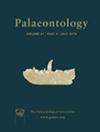检验古生物学方法在蛤虾(甲壳纲,鳃足纲)现存种上划界的成功
IF 2.3
2区 地球科学
Q1 PALEONTOLOGY
引用次数: 0
摘要
棘足动物化石的分类在很大程度上依赖于甲壳的特征(大小、形状、纹饰),古生物学家已经大大改进了研究和描述甲壳变异性的方法。单凭甲壳的特征是否足以区分同一属的物种还未得到检验。在我们的研究中,我们对481个现存的澳大利亚Ozestheria属的个体进行了常见的古生物学方法测试,这些个体先前根据遗传分析被划分为10个物种。基于几何形态计量学(p≤0.001),所有物种在形态上是不同的,但它们在Ozestheria形态空间中占据重叠区域。傅里叶形状系数的线性判别分析在所有可能的45个成对物种比较中达到93.8%的正确分类个体的平均模型性能。这可以通过结合大小和形状数据集来进一步提高。10个被调查的物种中有9个明显是两性二态的,但雄性和雌性形态在物种内强烈重叠,对模型性能影响很小。纹饰通常是物种诊断;共有7种纹饰类型,其中6种为物种特有,1种为4种共有。主要装饰特征的转变(例如从点状到光滑)可能发生在密切相关的物种中,这表明进化时间很短。我们的研究结果支持了甲壳特征的分类价值,这也应该在现存物种的分类中得到更多的关注。甲壳形状和纹饰的广泛变化值得注意,如果这些是化石,几个物种可能被分配到不同的属或科,这对化石Spinicaudata的系统学有影响。本文章由计算机程序翻译,如有差异,请以英文原文为准。
Testing the success of palaeontological methods in the delimitation of clam shrimp (Crustacea, Branchiopoda) on extant species
Fossil spinicaudatan taxonomy heavily relies on carapace features (size, shape, ornamentation) and palaeontologists have greatly refined methods to study and describe carapace variability. Whether carapace features alone are sufficient for distinguishing between species of a single genus has remained untested. In our study, we tested common palaeontological methods on 481 individuals of the extant Australian genus Ozestheria that have been previously assigned to ten species based on genetic analysis. All species are morphologically distinct based on geometric morphometrics (p ≤ 0.001), but they occupy overlapping regions in Ozestheria morphospace. Linear discriminant analysis of Fourier shape coefficients reaches a mean model performance of 93.8% correctly classified individuals over all possible 45 pairwise species comparisons. This can be further increased by combining the size and shape datasets. Nine of the ten examined species are clearly sexually dimorphic but male and female morphologies strongly overlap within species with little influence on model performance. Ornamentation is commonly species‐diagnostic; seven ornamentation types are distinguished of which six are species‐specific while one is shared by four species. A transformation of main ornamental features (e.g. from punctate to smooth) can occur among closely related species suggesting short evolutionary timescales. Our overall results support the taxonomic value of carapace features, which should also receive greater attention in the taxonomy of extant species. The extensive variation in carapace shape and ornamentation is noteworthy and several species would probably have been assigned to different genera or families if these had been fossils, bearing implications for the systematics of fossil Spinicaudata.
求助全文
通过发布文献求助,成功后即可免费获取论文全文。
去求助
来源期刊

Palaeontology
地学-古生物学
CiteScore
5.60
自引率
3.80%
发文量
43
审稿时长
6 months
期刊介绍:
Palaeontology publishes a wide variety of papers on palaeontological topics covering:
palaeozoology
palaeobotany
systematic studies
palaeoecology
micropalaeontology
palaeobiogeography
functional morphology
stratigraphy
taxonomy
taphonomy
palaeoenvironmental reconstruction
palaeoclimate analysis and biomineralization studies.
 求助内容:
求助内容: 应助结果提醒方式:
应助结果提醒方式:


